This is the time of year when, if we haven’t been out in the motorhome much, we start feeling the itch to escape. You read on the forums about a few rallies happening and consider booking one.
However, one thing holds you back: some rallies are held on grass, and your motorhome is useless on it. You want to go, but you dread getting your motorhome stuck in the mud.
You know your wheels spin on wet grass, let alone mud. Take comfort in knowing it’s not just your motorhome—it’s most of them.
Most motorhomes are front-wheel drive, which can be an advantage in many situations, but on mud, with most of the weight on the rear wheels, it’s not. A spinning wheel can dig a deep hole fast.
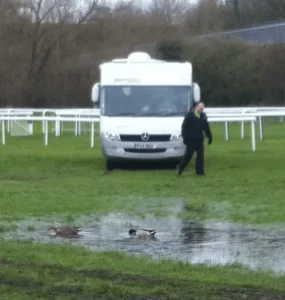
Should You Risk Getting Your Motorhome Stuck?
There’s no real danger in getting stuck. You and your motorhome might get muddy, your washing machine will be busy when you get home, and the van will need a good wash and polish, but that’s about it.
Some of the most fun and memorable gatherings have happened when everyone was bogged down, and people were being towed onto their pitches. Just accept that you’ll need a tow off and enjoy yourself.
Over the years, I’ve known some people who were really well and truly stuck, but none of them are still there—they all escaped the mud. If you’re unlucky enough to get stuck, you will too.
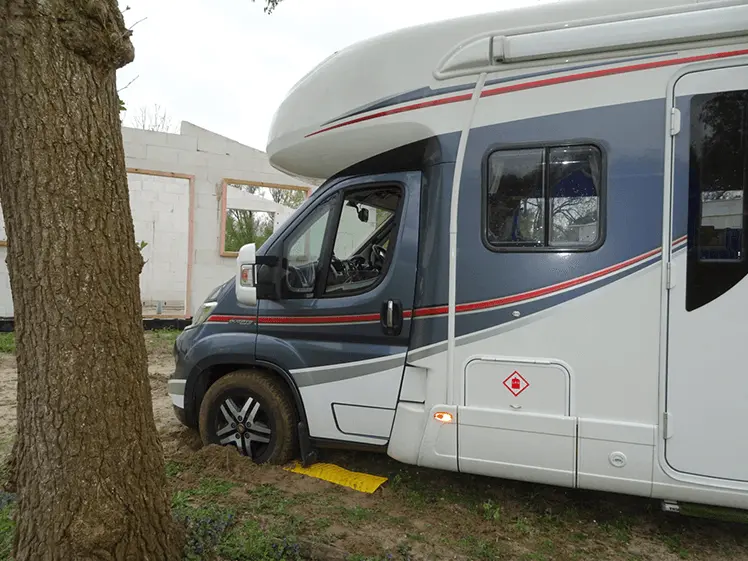
Getting Stuck on Your Own
When you’re stuck, it’s great to have friends with you or someone nearby who might give you a tow. However, if you’re wild camping, you might be on your own. In this case, make sure you do nothing to get yourself stuck because self-recovery techniques are always better with help.
Think About Towing Before You Commit
Some vehicles cannot be towed from the front. Similarly, some have no suitable area to be towed from the rear. On some A-Class motorhomes, the front bodywork extends lower than the axle, so tying a rope to the axle could damage the bodywork. There’s a similar dilemma with the rear skirts of some motorhomes.
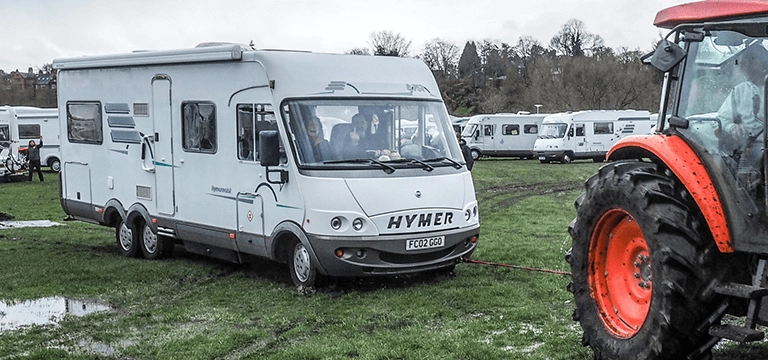
Front wheel drive vans with all the storage in the rear make the front drive wheels quite light. While most vans would struggle in conditions like this, my rearwheel drive motorhome drove straight out, just before this one got stuck. This explains the special wave I’m getting from the driver
Most of you will have a towing eye to screw into the front of the van. Make sure you know where it is and where it’s screwed in.
Some motorhomes will also have a fitted tow bar, handy for being recovered via the rear. If you have both, you’ve no need to worry. However, if you only have one towing option, make sure you position yourself accordingly. For example, I had an RV that could not be towed from the front, so I would never reverse into a place where I might need a tow.
Know where your tow points are. It’s much better to know now than to search for them in the mud and rain when you really need them.
Can I Minimise the Risk of Becoming Stuck?
Yes, there’s plenty you can do. The essential thing is to get out of your van and look at the ground. If you can dig your heel in and there’s a chance of rain, you might get stuck, especially in a front-wheel-drive motorhome.
Spread the Weight
Unless the ground is rock hard, always park on something that spreads the weight and stops your wheels from sinking into the mud. Without this, the weight of the van and the slight rocking movement within will ensure you sink, especially if it rains while you’re parked up.
You don’t need to sink far—just an inch or two can create a small dish under your wheels. When wet, even a bit of dew can make the wheels spin when you try to leave.
Over the years, I’ve seen various things used to spread the weight: scaffold boards, bits of old plywood, and rubber door mats. However, the most common item is the humble bread crate. Remove the sides, leaving a strong, square, or diamond mesh, and drive over them. They are strong enough to support three or four tons of motorhome.
Ideally, you’d have one under each wheel, but most people get by with just having them under the drive wheels.
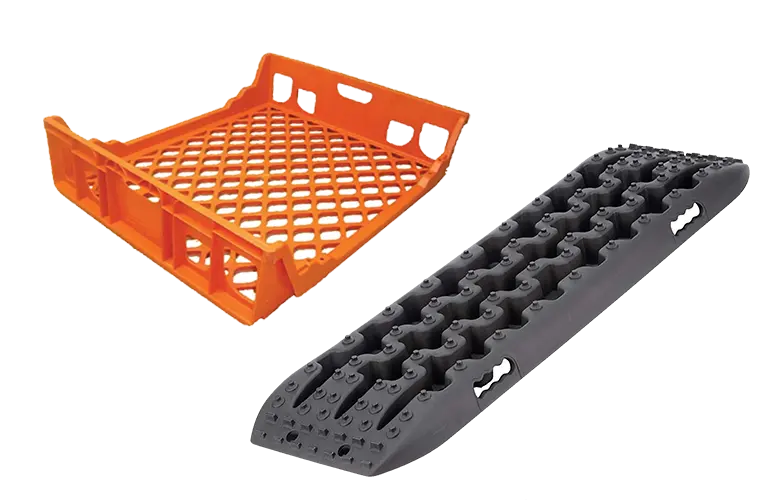
If you have the storage room, purpose-made sand ladders and waffle boards do a proper job. These are expensive and bulky but effective.
A common storage place is on the inside of a rear ladder, secured with bungees and a bicycle U-Bolt. Stored outside in this way, they’re easy to access and more likely to be used.
If you have any doubts about the conditions, drive onto your bread crates, ladders, or whatever you carry. Trying to get these items under your wheels once you’re already stuck is much more difficult.
When it’s time to leave, the traction these mats or ladders provide should be enough to get you going. If it’s really muddy, you might need to build a road to harder ground using twigs, gravel, straw, cab mats, carpet, or borrowed bread crates.
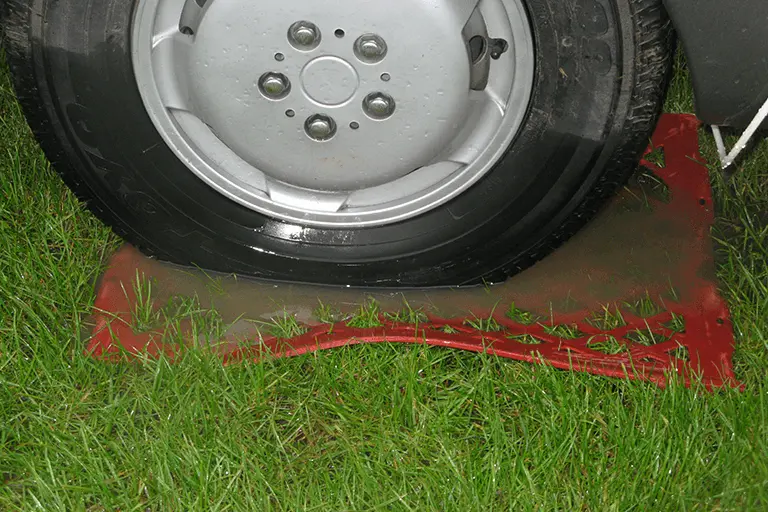
Here is a bread crate doing it’s job. The crate is a bit thin though, you can find them with a much thicker base. I’m sure most crates are stolen, but you can buy them from Ebay. Far better than the crate is the custom made track above. Expect to pay at least £90 for a good pair, but you’ll only buy them once.
Always Carry a Tow Rope
If there are caravans nearby, there will plenty of tow vehicles, but none of them will carry a tow rope. Always carry one for a better chance of being recovered. well under £20 from Amazon, even I find room for one in my 6m panel van. Maybe you’ll never use it for your own vehicle, but if your motorhome is stuck in the mud, you’ll be glad you had it.
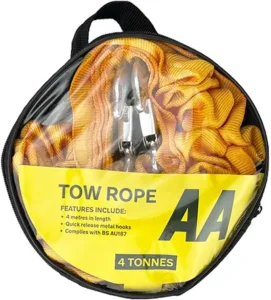
What If You Get Your Motorhome Stuck?
It should never be a surprise. If conditions are ripe for getting stuck, don’t make them worse. The main reason motorhomes get stuck is accelerating too fast. The tyres spin wildly, the tread fills up, and they throw mud everywhere, making extraction harder.
When you pull away, do so gently. Some say to start in second gear, but first or second, it doesn’t matter as long as you go easy on the throttle. If the wheels start spinning in place, STOP immediately. If you keep revving, you’re just digging a deeper hole.
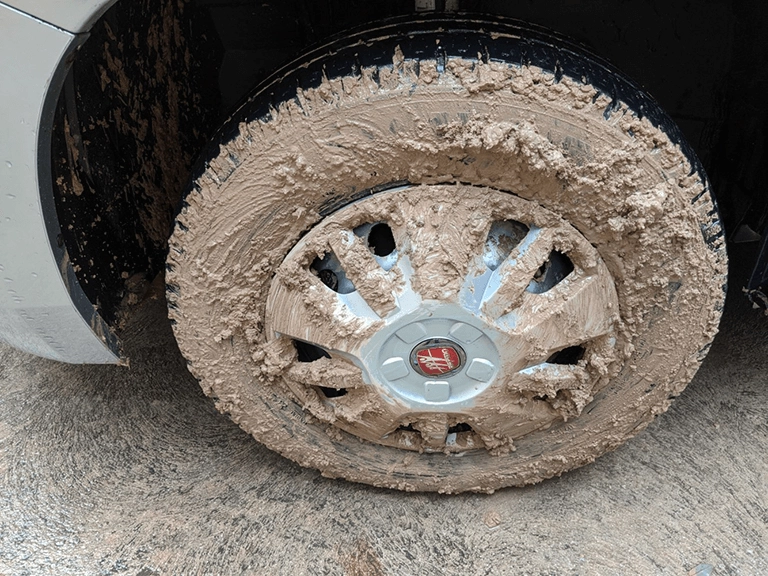
If you sink right up to your axles then extraction is much more difficult. STOP those wheels as soon as you are not moving forward.
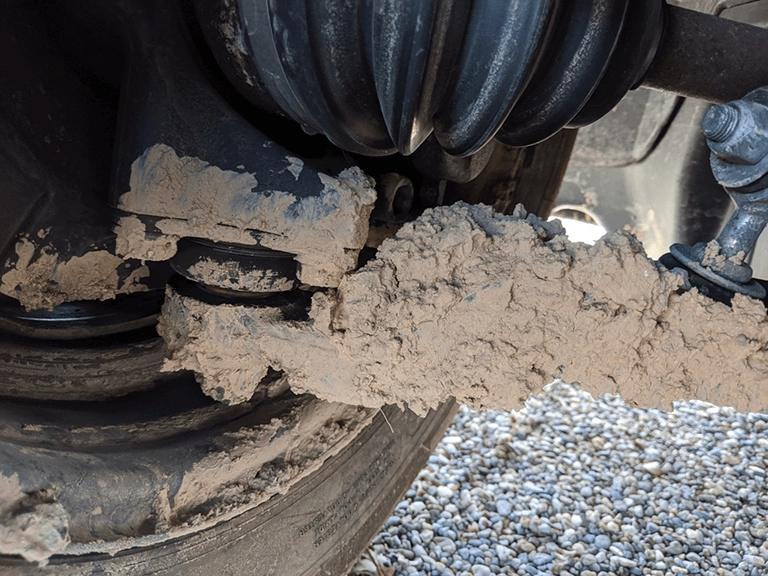
If you have a partner, have them watch the wheels. They might see the wheel spin quicker than you feel it and can shout STOP. Ensure anyone outside is always a couple of meters to the side and never at the front or rear.
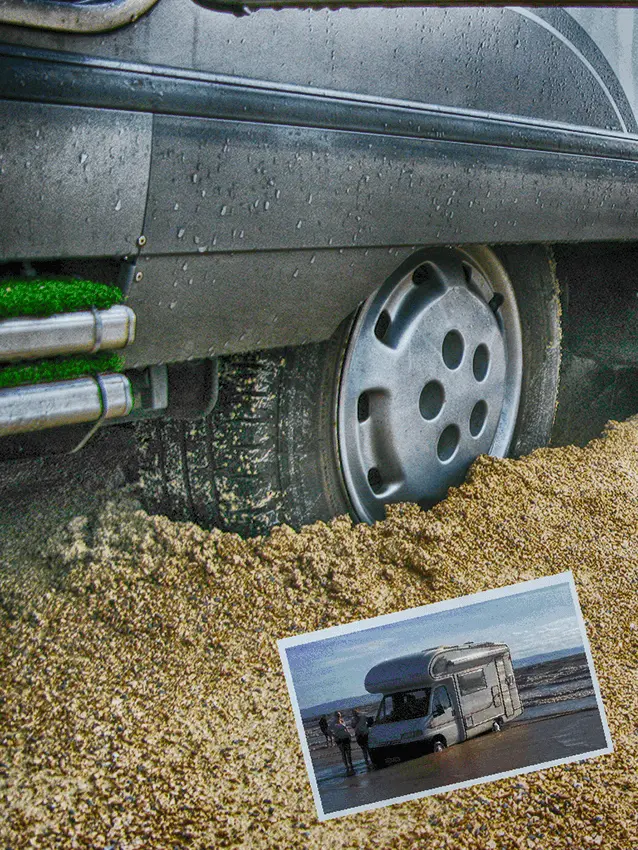
Digging yourself out of sand can be easier than mud. As long as you’re not pressed for time
Motorhome Stuck, Try Driving Out
Once your wheels have lost traction, and you’ve stopped moving forward, try to reverse out. You might not get far in reverse, but as soon as you stop moving back, engage first or second gear and rock forwards.
The momentum might get you a little further forward. Repeat this smooth rocking motion. Be mindful that gaining traction, especially in reverse, might make your motorhome speed up quickly. Be aware of hazards and ensure no one is behind you.
If rocking back and forth doesn’t work, your next best option is a tow. Hopefully, you’ll have a rope, making arranging the tow easier.
Pushing Someone Out when their motorhome is stuck in the mud
Never try to push someone out on your own. You risk being run over or hit by debris from spinning tyres. I’ve seen people pushed out with about 15 or 20 pushers, but this is not ideal. Parts of your van aren’t designed to have a 15-stone guy pushing on them, so only accept a group push as a last resort.
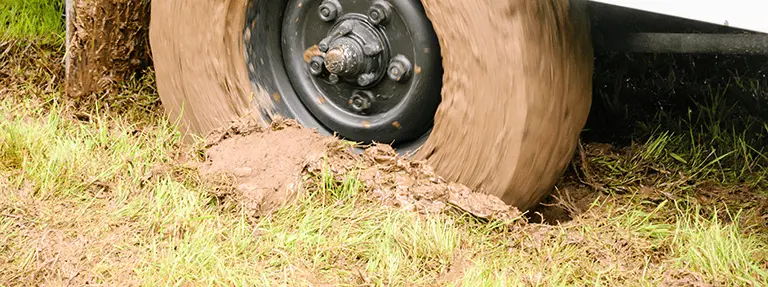
Being Towed
Ensure the rope is properly secured and everyone is well away from both vehicles. Tell the person towing you that you’ll sound the horn when ready and if you want them to stop, you’ll sound it again.
Make sure your wheels are pointed in the direction of the tow vehicle. Keep your wheels straight, the ignition on, and the engine at tick-over with the steering lock disengaged.
Concentrate on keeping your wheels straight and the brake lights of the tower. You might get towed quite a way if on a large rally field. Concentrate on your steering and, if necessary, use your brakes gently to keep tension in the tow rope and minimise snatching.
When you’re on good ground and stopped, ease forward a meter or so to make getting the tow rope off easier. Don’t forget to tip the tower!
Self Recovery
If you’ve tried everything and have no chance of a tow, you’ll need to dig. This is necessary to get things under the drive wheels. It’s far better to drive over a bread crate at the start of a rally than to dig one under a wheel after you’ve sunk.
You need to dig out enough earth in front of the wheel for it to roll onto the crate. Even an inch higher can be insurmountable for many vans. Be careful when the wheels are spinning—items can be shot out with velocity.
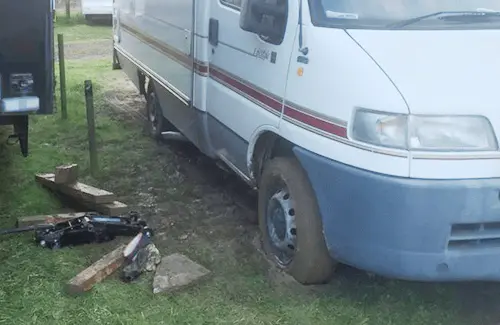
Look at the tools used here, stone, wood crates and jacks. If you sink too low you’ll struggle to get the Jack, along with something solid as a base, underneath.
The Jack Method
In January, I was called twice in one day to stuck vehicles on our CL Jasmin Camping. People drove onto the very soft grass to then reverse onto the hardstanding but got stuck. To tow them out, I would have had to drive my Land Rover onto the field, making a mess. Instead, I used a simple jack method.
I jacked up the drive wheels one at a time and placed bread crates under them. This can be hazardous. Ensure a secure base for the jack, and know the jacking point. I carry a three-ton low-lift bottle jack for self-extraction. You only need to lift the wheel an inch to get the crate underneath.
People with levelling jacks can use these instead of a bottle jack. Be careful using jacks in muddy conditions. Ideally, drop the jacks onto a wide, stable piece of wood and lift the motorhome minimum amount to get something under the wheels for traction.
Once the waffle boards or bread crates are under the drive wheels, you should be OK. Once the traction aids are under the drive wheels, you should be able to move.
If the ground is really soft, progress will be slow. As you move over a crate or board, on to another, you will need to stop, retrieve the crate from behind and place it in front of the wheels again. This process might need to be repeated several times until you reach more stable ground.
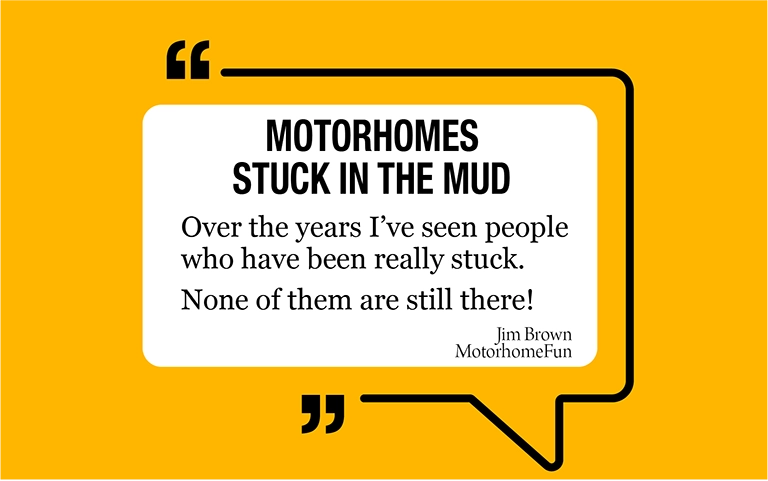
Most rallies, even in bad weather, end without anyone being towed. Experienced marshals will park you up to give you the best chance of escaping, facing slightly down hill for example. And if you get stuck and need a tow, its all part of the fun.
Let’s be areful, but let’s go, It’s only a bit of mud!
There are plenty of discussions on our forums cries for help when people get their motorhomes stuck in the mud. Have a read.
https://www.motorhomefun.co.uk/forum/threads/getting-stuck-in-mud.302384
https://www.motorhomefun.co.uk/forum/threads/so-did-anyone-else-get-stuck-over-easter.301042



